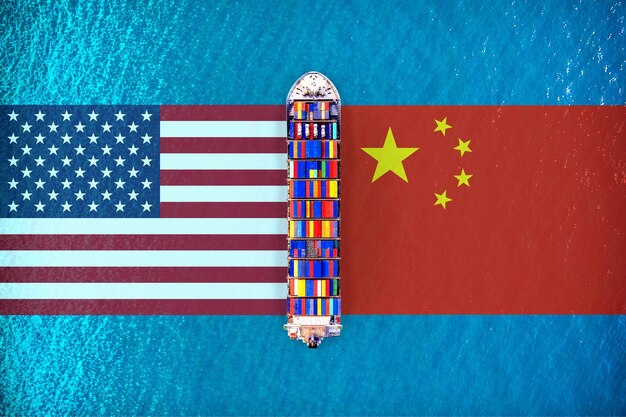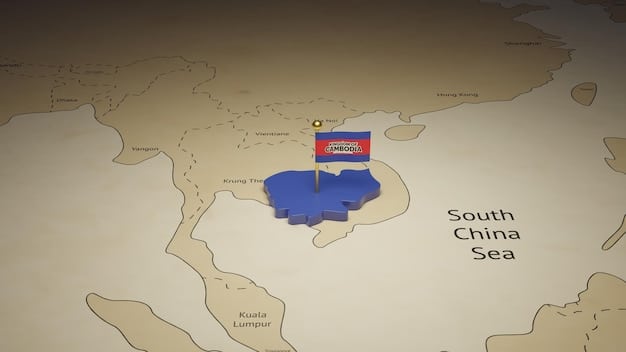US-China Relations: Trade, Tensions, and Future Prospects

US Relations with China: Navigating Trade Disputes and Geopolitical Tensions are complex, involving trade imbalances, technology competition, and differing political ideologies, shaping global stability and economic growth.
The intricate relationship between the United States and China, primarily defined by US Relations with China: Navigating Trade Disputes and Geopolitical Tensions, presents a multi-faceted challenge in the global arena. From trade imbalances to technological competition and geopolitical strategy, understanding these dynamics is crucial for anticipating future global trends.
Understanding the Historical Context of US-China Relations
The historical backdrop significantly influences the current state of US-China relations. Understanding the evolution of this relationship, from initial engagement to periods of tension, provides crucial context for navigating present-day challenges.
Early Engagement and Détente
The relationship between the US and China has evolved significantly over the last century. Early interactions were marked by missionary work and trade, but the communist revolution in China dramatically altered the dynamics.
The period of détente in the 1970s, initiated by President Nixon’s visit to China, marked a pivotal moment. This thaw in relations was driven by shared strategic interests, primarily to counter Soviet influence.

From Cooperation to Competition
Following détente, economic cooperation flourished. China’s opening up and reform policies attracted significant US investment. Trade volumes soared, fostering interdependence but also sowing the seeds for future trade imbalances.
However, this period of cooperation gradually shifted towards strategic competition. Issues related to human rights, intellectual property, and market access strained the relationship. The rise of China as a global power further intensified these tensions.
Here are some key historical milestones in the US-China relationship:
- 1972: Nixon’s visit to China opens the door for normalized relations.
- 1979: Formal diplomatic relations are established between the US and China.
- 2001: China joins the World Trade Organization (WTO), boosting trade ties.
- 2010s: Increased tensions due to trade imbalances and geopolitical issues.
In summary, the complex history of US-China relations, oscillating between cooperation and competition, greatly impacts the current landscape. Recognizing this background is essential for understanding present-day challenges.
The Core of Trade Disputes Between the US and China
Trade disputes are central to the turbulent dynamics between the US and China. These disputes, stemming from economic imbalances and differing trade practices, impact various sectors and raise concerns about fair competition.
Trade Imbalances and Tariffs
A significant aspect of trade disputes involves the trade imbalance. For years, the US has run a substantial trade deficit with China, leading to accusations of unfair trade practices. Tariffs have been implemented as a tool to address these imbalances.
The US has imposed tariffs on billions of dollars worth of Chinese goods, and China has retaliated with its own tariffs on US products. These tariffs disrupt supply chains and increase costs for consumers and businesses.
Intellectual Property and Market Access
Another critical aspect is the protection of intellectual property. The US has long accused China of widespread intellectual property theft, costing American companies billions of dollars annually. Enforcement mechanisms remain a key point of contention.
Market access is also a contentious issue. US companies often face restrictions and regulatory barriers when operating in China, while Chinese companies enjoy relatively open access to the US market.
Here are some major points of contention in US-China trade disputes:
- Trade Deficit: US aims to reduce its large trade deficit with China.
- Tariffs: The use of tariffs as a tool to influence trade practices.
- Intellectual Property: US seeks stronger protections for intellectual property.
- Market Access: Ensuring fair market access for US companies in China.
Ultimately, trade disputes highlight deeper systemic issues in the economic relationship between the US and China. Addressing these concerns requires comprehensive negotiations and commitment to fair trade practices.
Geopolitical Tensions in the South China Sea
Geopolitical tensions, particularly in the South China Sea, are a crucial element in the US-China relationship. These tensions involve territorial disputes, freedom of navigation, and the strategic balance of power in the Indo-Pacific region.
Territorial Claims and Freedom of Navigation
The South China Sea is a major source of contention. China’s expansive territorial claims, including the construction of artificial islands, have raised concerns among neighboring countries and the US.
The US asserts the principle of freedom of navigation in the South China Sea, conducting regular naval patrols to challenge China’s claims. These operations are viewed by China as provocative and an encroachment on its sovereignty.
Military Presence and Regional Security
The increasing military presence of both the US and China in the region further escalates tensions. China’s military expansion and the US’s commitment to its allies in the region create a complex security environment.
Regional security is also impacted by the diverse interests of other nations in the area. Countries such as Vietnam, the Philippines, and Japan have their own concerns regarding China’s assertiveness, leading to a multi-dimensional geopolitical challenge.

China’s assertive actions in the South China Sea have significant implications for the broader Indo-Pacific region. Continued dialogue and adherence to international law are essential for maintaining stability.
Key aspects of geopolitical tensions in the South China Sea include:
- Territorial Disputes: Conflicting claims over islands and maritime boundaries.
- Freedom of Navigation: US efforts to ensure navigation rights in the region.
- Military Presence: Increased military activities by both US and China.
- Regional Security: Impact on stability and security of neighboring countries.
The geopolitical tensions in the South China Sea represent a significant challenge for US-China relations. Effectively managing these tensions requires strategic diplomacy and a commitment to peaceful resolution.
Technology Race and Security Concerns
The technology race is a key dimension of US-China competition. Concerns about cybersecurity, data privacy, and the dominance of critical technologies like 5G have intensified the rivalry.
Huawei and 5G Technology
Huawei, a Chinese telecommunications giant, has been at the center of technology-related disputes. The US has raised concerns about the potential for espionage and security vulnerabilities associated with Huawei’s 5G technology.
The US has urged its allies to restrict or ban Huawei from their 5G networks, leading to debates and divisions among nations. This issue underscores the intersection of technology, security, and international relations.
Cybersecurity and Data Privacy
Cybersecurity is another critical concern. Both the US and China have been accused of conducting cyber espionage and attacks. The protection of sensitive data and critical infrastructure is a top priority.
Data privacy is also a growing concern. As technology companies collect vast amounts of personal data, questions arise about how this data is used and protected. Cross-border data flows and regulatory frameworks are key areas of discussion.
Key elements of the technology race and security concerns include:
- Huawei: Concerns about espionage and security vulnerabilities.
- 5G Technology: Competition for dominance in next-generation networks.
- Cybersecurity: Protecting against cyber espionage and attacks.
- Data Privacy: Ensuring the security and privacy of personal data.
In short, the technology race between the US and China raises complex security and economic considerations. Addressing these concerns requires international cooperation and the establishment of clear regulatory standards.
The Impact of Human Rights Issues
Human rights issues significantly impact US-China relations. Concerns over human rights in Xinjiang, Hong Kong, and other regions remain a persistent point of contention. These issues often complicate diplomatic and economic interactions.
Xinjiang and the Treatment of Uyghurs
The treatment of Uyghurs and other ethnic minorities in Xinjiang has drawn international condemnation. Reports of human rights abuses, including mass detentions and forced labor, have led to sanctions and diplomatic pressure.
China defends its policies in Xinjiang as necessary to combat extremism and promote economic development. However, human rights organizations and Western governments maintain that these policies violate fundamental human rights.
Hong Kong and Democratic Freedoms
The erosion of democratic freedoms in Hong Kong is another major concern. The imposition of the National Security Law has curtailed civil liberties and undermined the autonomy promised to Hong Kong under the “One Country, Two Systems” framework.
The US has responded with sanctions and other measures to hold China accountable for its actions in Hong Kong. These measures aim to protect democratic values and support the rights of the people of Hong Kong.
Key human rights issues affecting US-China relations include:
- Xinjiang: Treatment of Uyghurs and other ethnic minorities.
- Hong Kong: Erosion of democratic freedoms and autonomy.
- Tibet: Concerns about religious freedom and cultural preservation.
- Political Dissidents: Imprisonment and persecution of political activists.
To summarize, human rights issues remain a significant challenge in US-China relations. Addressing these concerns requires sustained international pressure and a commitment to upholding human rights standards.
Future Prospects and Potential Scenarios
The future of US-China relations is uncertain, with various potential scenarios. Different approaches, from continued competition to cooperation on shared interests, could shape the trajectory of this critical relationship.
Continued Competition and Strategic Rivalry
One possible scenario involves continued competition and strategic rivalry. This approach would see the US and China vying for influence in various domains, including trade, technology, and geopolitics. Tensions could persist, leading to periodic crises.
In this scenario, the focus would be on containing China’s rise and maintaining US leadership. Alliances and partnerships would play a crucial role in balancing China’s influence.
Cooperation on Shared Interests
Another scenario involves greater cooperation on shared interests. Issues such as climate change, global health, and nuclear proliferation could provide opportunities for collaboration. This approach would emphasize dialogue and mutual understanding.
In this scenario, the US and China would seek to manage their differences while working together to address global challenges. However, this approach would require a willingness to compromise and find common ground.
Several potential scenarios could shape the future of US-China relations:
- Continued Competition: Focus on containing China’s rise and maintaining US leadership.
- Cooperation on Shared Interests: Emphasizing collaboration on global challenges.
- Escalation: Increased tensions leading to potential conflict.
- Reset: A fundamental shift towards improved relations and mutual trust.
In conclusion, the future of US-China relations depends on the choices made by leaders in both countries. A balanced approach that combines competition with cooperation is essential for managing this complex relationship.
| Key Point | Brief Description |
|---|---|
| 🤝 Historical Context | Evolving from cooperation to competition. |
| 💰 Trade Disputes | Imbalances, tariffs, IP theft are central issues. |
| 🌐 Geopolitical Tensions | South China Sea tensions persist. |
| 🔬 Technology Race | 5G and cybersecurity are key concerns. |
What are the main challenges in US-China relations?
▼
The main challenges include trade imbalances, geopolitical tensions in regions like the South China Sea, technology competition, and human rights issues related to Xinjiang and Hong Kong.
▼
Trade disputes can disrupt supply chains, increase costs for consumers and businesses, and create uncertainty in the market, affecting various economic sectors and overall growth.
▼
The US asserts freedom of navigation in the South China Sea, challenging China’s territorial claims and construction of artificial islands, viewing these actions as destabilizing to the region.
▼
Human rights concerns in Xinjiang include reports of mass detentions, forced labor, and other abuses against Uyghurs and other ethnic minorities, leading to international condemnation.
▼
Greater cooperation on shared interests like climate change and global health and dialogue with mutual trust can pave the way for improving relations despite ongoing competition and disagreements.
Conclusion
Navigating US Relations with China: Navigating Trade Disputes and Geopolitical Tensions requires a balanced approach, adept diplomacy, and a firm commitment to addressing areas of conflict while seeking opportunities for collaboration and mutual benefit to maintain global stability.





